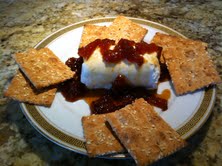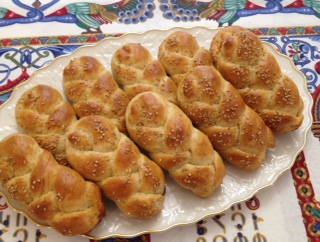Have you ever heard Khashlama (Hashlama)? I hadn’t, until recently.
Khashlama, simply put, is a boiled meat dish, generally beef or lamb (or mutton, where available) seasoned with herbs and some salt – a stew, of sorts, in its most basic form.
Irina Petrosian, author of ‘Armenian Food – Fact, Fiction and Folklore’ describes khashlama as “a favorite for Armenian food lovers who enjoy natural, plain flavors.”
 Petrosian also makes reference to khashlama from the cookbook, “The Oriental Cookbook – Wholesome, Dainty and Economical Dishes of the Orient, Especially Adapted to American Tastes and Methods of Preparation”, by Ardashes Keoleian, formerly of Constantinople, printed in 1913. Keoleian indicated that khashlama is an economical, popular dish where you make separate use of meat and broth.
Petrosian also makes reference to khashlama from the cookbook, “The Oriental Cookbook – Wholesome, Dainty and Economical Dishes of the Orient, Especially Adapted to American Tastes and Methods of Preparation”, by Ardashes Keoleian, formerly of Constantinople, printed in 1913. Keoleian indicated that khashlama is an economical, popular dish where you make separate use of meat and broth.
His cookbook offers numerous khashlama recipes, including boiled brain, tongue, beef, part-or-all of a lamb, chicken, and more. Some khashlama recipes include vegetables, other versions are plain, but all of them have the basic components of meat and broth.
Here is the most basic recipe for Khashlama (Hashlama) from Mr. Keoleian’s cookbook:
BOILED MEAT A LA ARMENIA.
[Ebmeni Et Hashlama Teetibi.]
Ingredients :
Meat 3 to 4 pounds, leg, haunch or shoulder of beef, mutton or lamb (or in desired quantity).
Parsley 1 bunch.
Dry Onions 2, medium.
Tomatoes 2, ripe (or 3 to 4 tablespoonfuls of canned tomatoes).
Salt and pepper, to taste.
Method:
Take the meat, wash and put in a vessel with sufficient amount of cold water. Bring it to a boil and take the scum off. Boil until the meat is tender.
After boiling the meat as directed, put the meat into a separate deep pan, pierce it on all sides with a pointed sharp knife, and chop over it the onions and the tomatoes. (Some would insert peeled bulbs of garlic in the pierced places on the meat.)
Pour over a cupful of the broth. Season the whole to taste and place in a moderately hot oven until the vegetable ingredients are fully cooked.
Serve hot and sliced, use own gravy as sauce.
 |
| Khashlama – ready to serve |
Khashlama (Kalajian-style)
Serves 4
Ingredients:
2 lbs. lean lamb, cut into 1 inch cubes
1 large onion, coarsely chopped
2 fresh tomatoes, diced
1 medium onion, sliced
2 cloves garlic, thinly sliced
½ large yellow pepper, coarsely chopped
½ large red pepper, coarsely chopped
½ cup flat leaf parsley (stems removed; leaves left whole)
½ cup crushed tomato
¼ cup tomato paste
2 cups lamb broth (water, beef or chicken broth may be substituted)
1 tsp. marjoram, or to taste
Salt, black pepper and paprika, as needed
 |
| Cooking lamb cubes on the stovetop |
Directions:
1. Place lamb cubes in a large pot, cover with water, and bring to a boil. Reduce heat to medium. Remove scum as it rises to the surface. Cook, uncovered, until meat starts to become tender, about 1 hour.
2. Remove meat from pot with a slotted spoon; place in a casserole dish. Season meat with marjoram, salt, pepper, and paprika. Toss to coat.
3. Strain lamb broth and pour into a liquid measuring cup. Add water, if necessary, to make 2 cups.
 |
| Vegetables, broth and lamb ready to bake |
4. Add the tomatoes, onion, garlic, peppers and parsley to the meat in the casserole dish. Gently toss.
5. Mix together the tomato puree, tomato paste and lamb broth. Pour liquid over the meat and vegetables, gently mixing together.
6. Bake, covered with aluminum foil, in a moderate, preheated (350°F) oven for 1 hour. Remove the foil and continue baking for additional 30 minutes, or until meat is very tender.
Serve in a bowl with bread (for dipping) or over bulgur pilaf.




Here Is an excellent variation my mom taught me. Layer the meat, veggies, and herbs. Ads enough water to full half the pot. Add one bottle of beer. Being it to a boil. Lower the heat and let it cook until the meat is soft. I also use veal instead of beef as it is more tender. This is the Hayastanci method. Happy cooking.
Marine, that's an interesting approach! I never heard of adding beer to khashlama, but why not? I'm sure it adds a deep flavor. Is this completely cooked on the stovetop?
Yes. On the stove top. May need to add extra water as needed. Also if you put onions all the way on the bottom it'll keep the bburning confined to the onions. It's so delicious and easy.
my grandfather was from moosh and he made "khash" regularly. but it did not resemble this recipe at all. it was more of a liquid head cheese if you may. it was filled with tripe and bones and all sorts of things that i wouldn't eat, and it was in a clear looking broth…no vegetables although there may have been onions and garlic added for flavor. when refrigerated it was gelatinous. huge quantities were made to accomodate the numerous ingredients and the dog thought it was in heaven when presented his own bowl full.
for some reason, i thought khash just meant a pot of everything imaginable put into it, which may explain that everyone made their own version of khash.
Hi Koharig, Khash and khashlama are quite different, as you have noted. I'd eat khashlama, but khash … I'm not so sure!
Khashlama is Georgian cuisine!!!!!
As the time states 4 20 I'm assuming you are high and you don't know that Armenians taught your culture how to cook and then we were nice enought and smart enought to make you a alphabet go online and look up what armenians have done for you before making dum dum comments online for the world to read
We gave Georgia a alphabet and taught them how to make food taste good and now armenian recipes are Georgian wow go get a life
Yup… Famous Armenian legends that you guys try so hard to make others believe… Come on already, stick to your history, your tradition, your goods and your bads and leave others be… Aren't you tired of desperately crying that everything's origins are in Armenia?
This is funny how they are assuming everything's origins are in armenia when even most of their meals' names origin is not armenian language (khashlama comes from aş/haşlamak which means meal/cooking, in Turkish.)
Nonsense, the Turkish word haşlamak meaning "to boil" is a Turkish word of Armenian origin (just like örnek). The original Turkish word for boiling is kaynatmak, see also other Turkic languages qaynatmoq in Uzbek, qaynamaq in Azeri, kaynatu in Kazakh, kaynatuu in Kyrgyz, gaynatmak in Turkmen etc. khashlama and khash both derive from the old Armenian term xašel which means "to boil" and this is attested in medieval cookbooks from Armenian monks. Armenians did adopt foreign foods like churchkhela, manti or bozbash, but khashlama and khash both derive from Armenian cuisine.